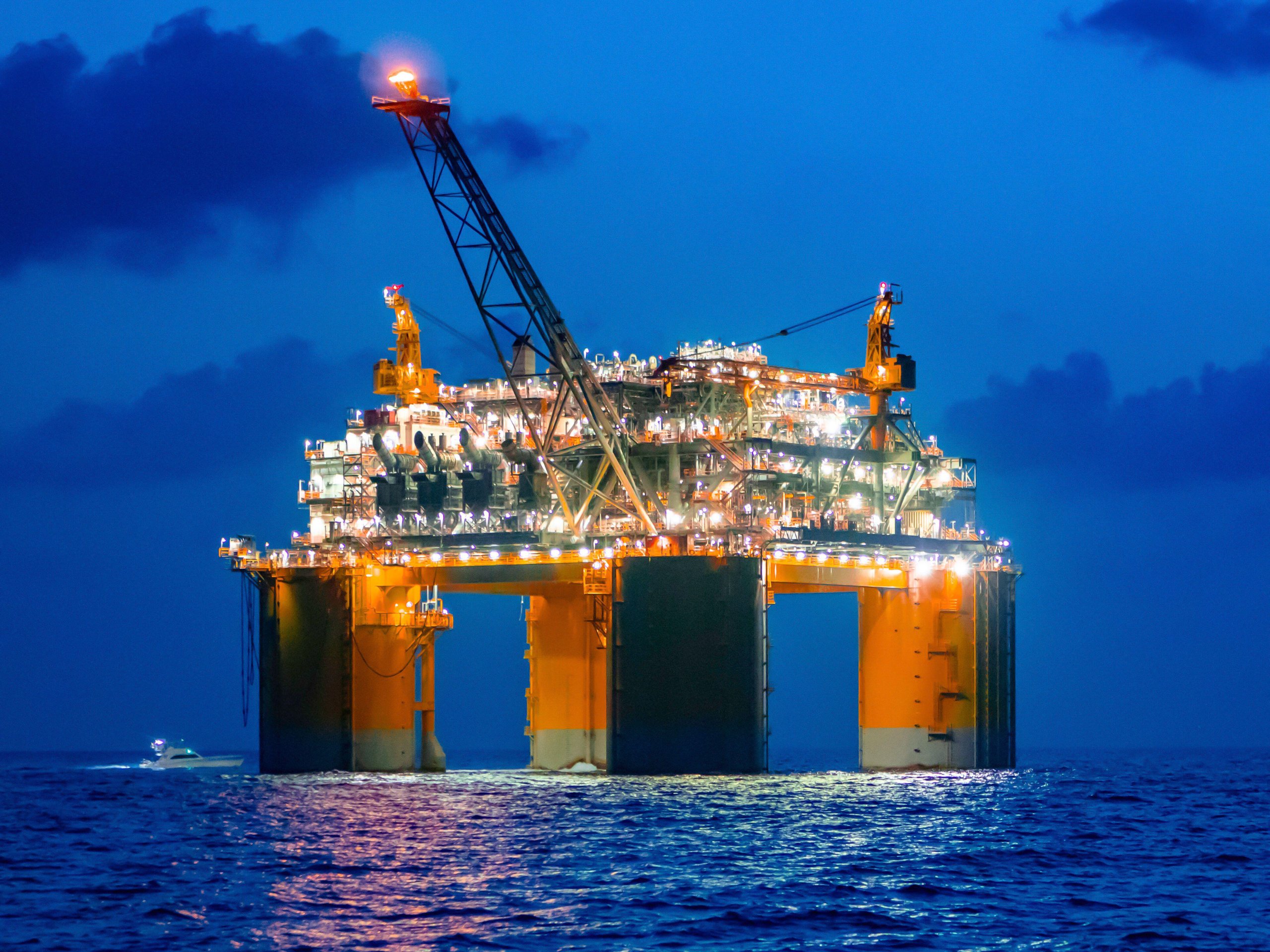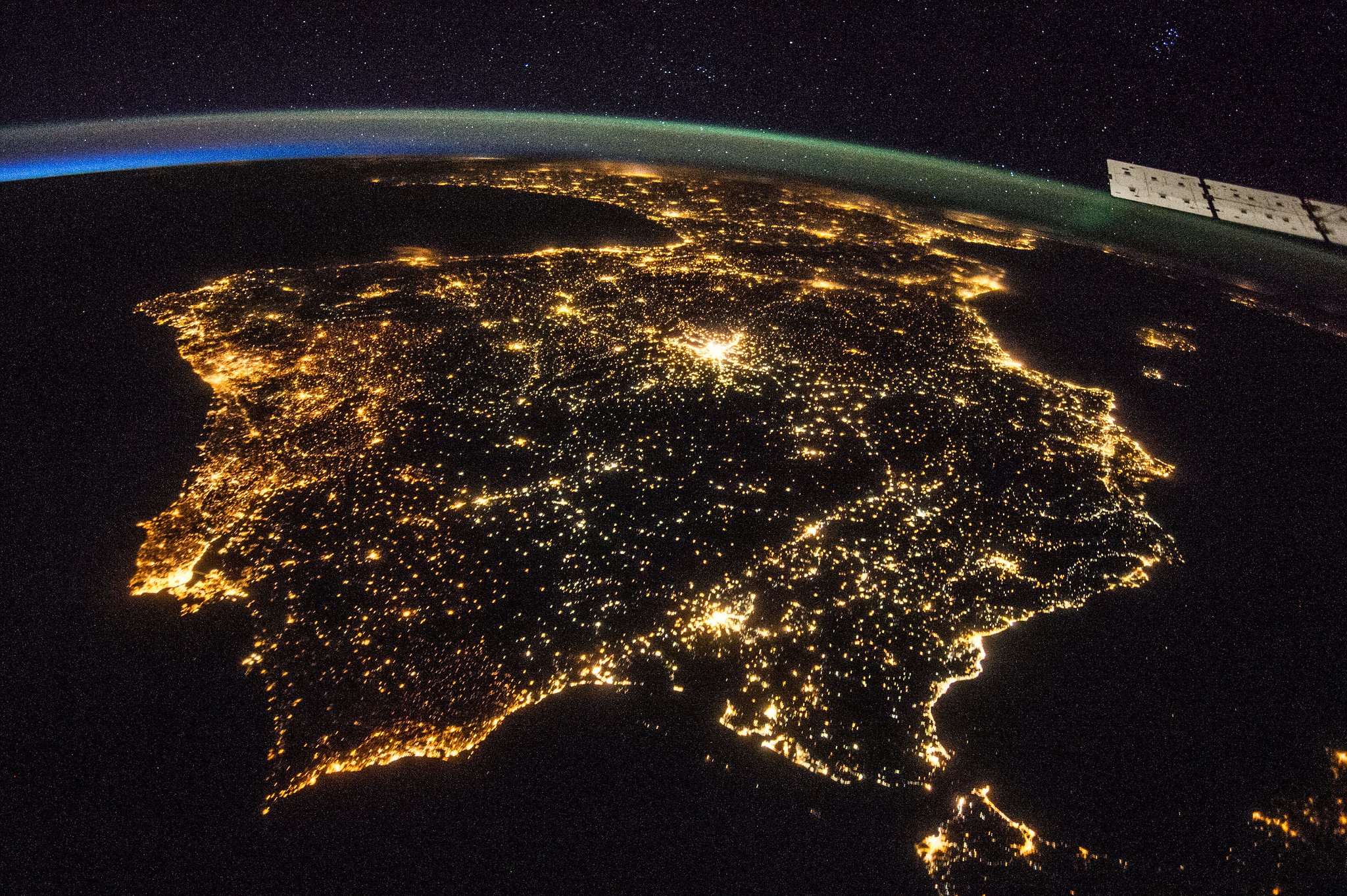
An oil platform in the Gulf of Mexico.
Industry is a major source of ocean light pollution – a problem that has received minimal attention to date
(Image: Cavan Images / Alamy Stock Photo)
From Dialog Earth by Daniel Cressey
Scientists increasingly understand the damage done by artificial light and action is needed now, Thomas Davies tells Dialogue Earth
For years the world has largely ignored an insidious pollutant humanity has been carelessly throwing into the ocean: light.Scientists increasingly understand the damage done by artificial light and action is needed now, Thomas Davies tells Dialogue Earth
Newly hatched turtles can be sent off course by the glow of nearby beachfront restaurants, taking them away from the sea and to their deaths.
Scientists have shown that marine birds can become so confused by artificial light that they drop from the sky in “fallout events”.
But the issue of just how pervasive and damaging artificial light is at sea has struggled to garner the attention it deserves, lagging behind greenhouse gases, plastics and noise in the pantheon of pollutions plaguing the oceans, says Thomas Davies.
Davies, a marine conservation researcher at the University of Plymouth in the United Kingdom, is one of the leaders of the Global Ocean Artificial Light at Night Network.
This group of leading experts on marine light pollution launched earlier this year to try and remedy the situation.
Davies spoke to Dialogue Earth about how light impacts everything from breeding to feeding to movement in the sea, how the problem is likely to get worse before it gets better, and what should be done about it now.
The interview has been edited for length and clarity.
Dialogue Earth: How did you start working on ocean light pollution?
Thomas Davies: It wasn’t really around as a subject at all until about 2014.
For years, nobody was really thinking about this beyond sea birds and sea turtles.
Nobody was thinking about the broader impacts of light pollution on marine ecosystems.
I think biologists assumed that there just wasn’t sufficient artificial light reaching into the marine environment to cause biological impacts.
As soon as you realise as a marine ecologist how fundamental light is in shaping the marine environment, suddenly it becomes really obvious how light pollution might be doing the same thing down to 100 metres plus.
100 metres seems a long way down…
The 100 metres case is taken from a situation with Calanus copepods [tiny crustaceans] that live in the Northeast Atlantic and sub polar regions, which are really important for carbon budgets and the food web in those regions.
They normally migrate up to the surface at nighttime to feed and then migrate down during the daytime, presumably to avoid predation.
But if you turn your ship lights on [at night], then they basically scatter sideways and downwards to get away from the light sources.
It’s an instantaneous response.
You can see these deep holes where the zooplankton should be, where the light is penetrating down into the water.
Vertical migration can be suppressed down to 100 metres depth.
Thomas Davies: It wasn’t really around as a subject at all until about 2014.
For years, nobody was really thinking about this beyond sea birds and sea turtles.
Nobody was thinking about the broader impacts of light pollution on marine ecosystems.
I think biologists assumed that there just wasn’t sufficient artificial light reaching into the marine environment to cause biological impacts.
As soon as you realise as a marine ecologist how fundamental light is in shaping the marine environment, suddenly it becomes really obvious how light pollution might be doing the same thing down to 100 metres plus.
100 metres seems a long way down…
The 100 metres case is taken from a situation with Calanus copepods [tiny crustaceans] that live in the Northeast Atlantic and sub polar regions, which are really important for carbon budgets and the food web in those regions.
They normally migrate up to the surface at nighttime to feed and then migrate down during the daytime, presumably to avoid predation.
But if you turn your ship lights on [at night], then they basically scatter sideways and downwards to get away from the light sources.
It’s an instantaneous response.
You can see these deep holes where the zooplankton should be, where the light is penetrating down into the water.
Vertical migration can be suppressed down to 100 metres depth.

What is the largest current concern about ocean light pollution?
I think the biggest emerging concern is probably with the corals.
There is an increasing body of knowledge now, which is showing us the huge variety of ways in which light pollution can shape coral physiology, shape broadcast spawning, and shape their daily activity cycles in terms of when they feed.
I think the biggest emerging concern is probably with the corals.
There is an increasing body of knowledge now, which is showing us the huge variety of ways in which light pollution can shape coral physiology, shape broadcast spawning, and shape their daily activity cycles in terms of when they feed.
What is broadcast spawning?
This is when animals reproduce by ejecting sperm and eggs into the water, rather than mating.
Corals do this in a mass release synchronised across entire reef systems.
If this synchronisation is disrupted, and corals release at different times, it can reduce the exchange of genetic information.
Sperm and eggs may be more likely to be eaten by predators, and the tidal distribution of sperm, eggs and resulting larvae may be impacted.
That presents a really big issue because obviously, corals are under threat from multiple different things at the moment, but also corals by their ecology tend to inhabit waters that are very clear.
So exposure of coral reefs to light pollution which is biologically relevant to them is quite widespread.
Do you think light pollution is likely to increase in future?
Yes, I think it is, especially in the developing world.
Coastal populations are projected to increase quite significantly by 2050.
And a lot of that is going to occur in developing economies.
It will develop along coasts, where the trade comes, where the rivers emerge, where the ports and harbours are.
That’s where the cash tends to be.
There is going to be a lot of urban development along coastlines.
If you look at stretches of the Iberian Peninsula from the nighttime satellites, you can’t actually see any breaks in the lights moving across the whole of the south coast of Spain from the Rock of Gibraltar.
That kind of development is on par for some parts of Southeast Asia.
It will be quite severe.

The Iberian Peninsula, seen here at night from the International Space Station, shows how coastal development can generate enormous amounts of light pollution
What should change about how we light the ocean?
First of all, people need to consider whether they need light in the first place.
Then, how much light they need, where they need it, and when.
At that point, they need to consider whether or not the colour of that light can be altered to avoid ecological impacts.
The decision-making process should go in that order.
If we can get some lighting regulations to reduce light pollution from offshore infrastructure, that would be good.
If we could get some regulations to manage lighting on vessels at sea, that would be useful as well.
Currently, there is almost no regulation.
It’s a case of making sure that we get light pollution integrated into the international and national policy frameworks in the same way that noise pollution has been over the last 10 years.
I think we’ve got a 10-year journey ahead of us to achieve that.
Where do you – and the Global Ocean Artificial Light at Night Network – go from here?
A key objective for GOALANN is moving the science into the policy agenda and to try to reach out to big international organisations, in the hope of being able to make some meaningful change in terms of the impacts of light pollution.
We’re just in that phase now where the science has moved to a point where we can start to really have that influence, and I think we need to start that kind of impact agenda now.
To try and see if we can start to make a difference.
You start doing the science and then you need to try to make the science make a difference.
A key objective for GOALANN is moving the science into the policy agenda and to try to reach out to big international organisations, in the hope of being able to make some meaningful change in terms of the impacts of light pollution.
We’re just in that phase now where the science has moved to a point where we can start to really have that influence, and I think we need to start that kind of impact agenda now.
To try and see if we can start to make a difference.
You start doing the science and then you need to try to make the science make a difference.
Links :
- Darksky : From the beach to the seafloor, light pollution interferes with marine life
- The Guardian : Artificial light on coastlines lures small fish to their doom, coral reef study finds / Treat artificial light like other forms of pollution, say scientists
- Cornell : Light pollution threatens coastal marine systems
- The Conversation : Urban light pollution is a danger for marine ecosystems – new research
- NASA : Bathed in a Sea of Artificial Light
- Phys : Light pollution affects coastal ecosystems, too—this underwater 'canary' is warning of the impacts
- Scientific American : Light Pollution from Coastal Cities Reaches Seafloor
- Mongabay : The dark side of light: Coastal urban lighting threatens marine life, study shows
- Nature : Biologically important artificial light at night on the seafloor
No comments:
Post a Comment